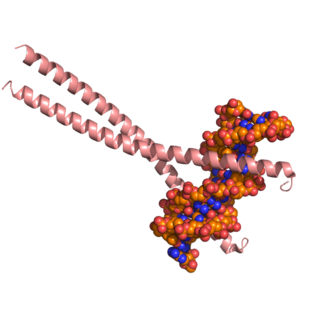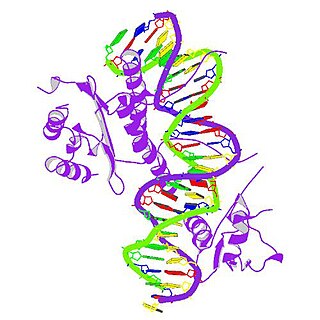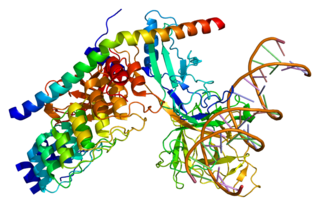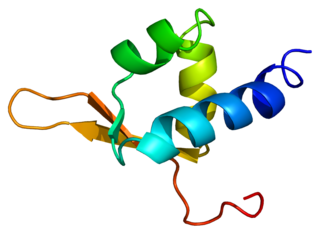Activating transcription factor 5, also known as ATF5, is a protein that, in humans, is encoded by the ATF5 gene. [5]
Activating transcription factor 5, also known as ATF5, is a protein that, in humans, is encoded by the ATF5 gene. [5]
First described by Nishizawa and Nagata, [6] ATF5 has been classified as a member of the activating transcription factor (ATF)/cAMP response-element binding protein (CREB) family. [7] [8]
ATF5 transcripts and protein are expressed in a wide variety of tissues, in particular, high expression of transcripts in liver. It is also present in a variety of tumor cell types.
ATF5 expression is regulated at both the transcriptional and translational level.
ATF5 is expressed in VZ and SVZ during brain development.
The human ATF5 protein is made up of 282 amino acids.
ATF5 is a transcription factor that contains a bZip domain.
ATF5 has been shown to interact with DISC1 [9] and TRIB3. [10]

P300/CBP-associated factor (PCAF), also known as K(lysine) acetyltransferase 2B (KAT2B), is a human gene and transcriptional coactivator associated with p53.

CCAAT/enhancer-binding protein beta is a protein that in humans is encoded by the CEBPB gene.

SUMO-conjugating enzyme UBC9 is an enzyme that in humans is encoded by the UBE2I gene. It is also sometimes referred to as "ubiquitin conjugating enzyme E2I" or "ubiquitin carrier protein 9", even though these names do not accurately describe its function.

Transcription factor JunD is a protein that in humans is encoded by the JUND gene.

Transcription factor jun-B is a protein that in humans is encoded by the JUNB gene. Transcription factor jun-B is a transcription factor involved in regulating gene activity following the primary growth factor response. It binds to the DNA sequence 5'-TGA[CG]TCA-3'.

Cyclic AMP-dependent transcription factor ATF-3 is a protein that, in humans, is encoded by the ATF3 gene.

Cyclic AMP-dependent transcription factor ATF-1 is a protein that in humans is encoded by the ATF1 gene.

Activating transcription factor 4 , also known as ATF4, is a protein that in humans is encoded by the ATF4 gene.

Activating transcription factor 6, also known as ATF6, is a protein that, in humans, is encoded by the ATF6 gene and is involved in the unfolded protein response.

Serum response factor, also known as SRF, is a transcription factor protein.

Activating transcription factor 2, also known as ATF2, is a protein that, in humans, is encoded by the ATF2 gene.

Myocyte-specific enhancer factor 2A is a protein that in humans is encoded by the MEF2A gene. MEF2A is a transcription factor in the Mef2 family. In humans it is located on chromosome 15q26. Certain mutations in MEF2A cause an autosomal dominant form of coronary artery disease and myocardial infarction.

Cyclic AMP-responsive element-binding protein 3 is a protein that in humans is encoded by the CREB3 gene.

MAP kinase-interacting serine/threonine-protein kinase 2 is an enzyme that in humans is encoded by the MKNK2 gene.

CAMP responsive element binding protein-like 1, also known as CREBL1, is a protein which in humans is encoded by the CREBL1 gene.

Activating transcription factor 7-interacting protein 1 is a protein that in humans is encoded by the ATF7IP gene.

Mastermind-like protein 1 is a protein that in humans is encoded by the MAML1 gene.

Basic leucine zipper transcription factor, ATF-like, also known as BATF, is a protein which in humans is encoded by the BATF gene.

Cyclic AMP-dependent transcription factor ATF-7 is a protein that in humans is encoded by the ATF7 gene.

General transcription factor IIF subunit 2 is a protein that in humans is encoded by the GTF2F2 gene.
This article incorporates text from the United States National Library of Medicine, which is in the public domain.